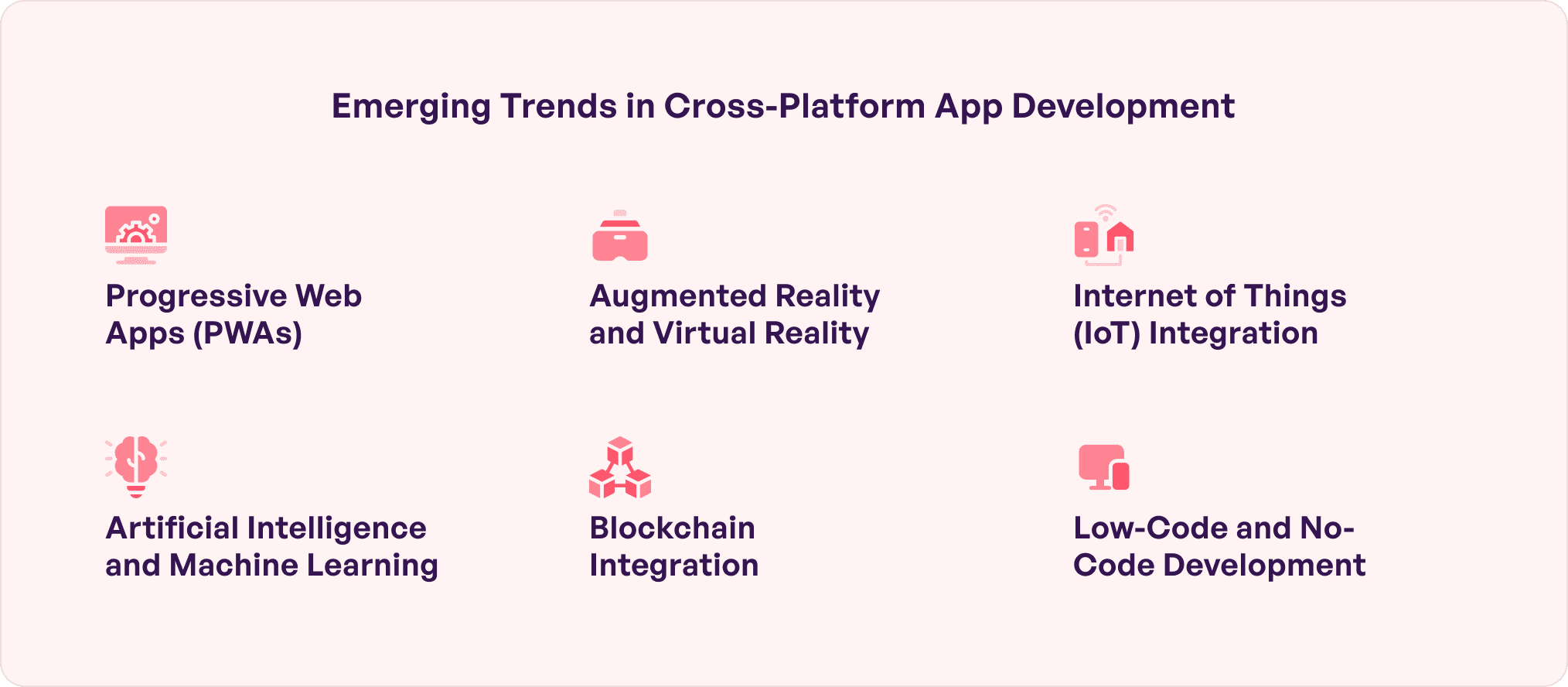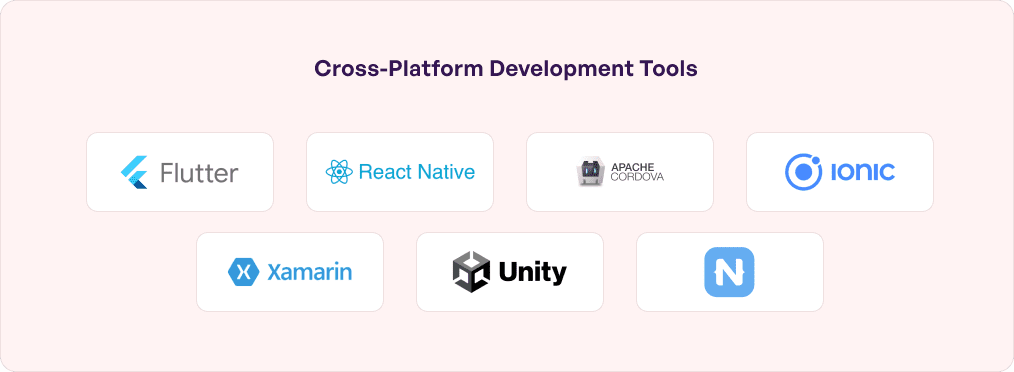Mobile apps have taken center stage in today’s digital landscape, shaping our daily routines and interactions. From ordering food to managing finances, cross-platform apps have become crucial. As businesses strive to engage customers across various platforms, the choice between native and cross-platform development emerges as critical.
Cross-platform development is gaining momentum as a versatile solution to reach diverse audiences seamlessly. With over 6.84 billion smartphones globally, it’s clear that people everywhere crave apps, regardless of the operating system they use. By adopting cross-platform development, businesses can streamline costs, save time, and broaden their market reach.
In particular, startups face challenges like compatibility issues, design, and UI/UX inconsistencies in app development. Cross-platform tools offer a unified approach, easing resource constraints and time pressures. By eliminating the need for separate versions, businesses can efficiently navigate the complexities of app development.
The shift towards cross-platform development in a rapidly evolving digital landscape reflects the search for efficiency and competitiveness. Whether targeting Android or iOS, the choice between native and cross-platform development shapes the app’s trajectory, influencing design, technology, and accessibility. It’s time to accept cross-platform development and unlock a world of possibilities for your app.
Table of contents
The current market overview of cross-platform app development
The cross-platform app development scene is buzzing with energy and growth. As the digital world expands, so does the global demand for mobile apps across industries. This hunger for apps drives businesses towards cross-platform solutions, which promise a broader reach by catering to both iOS and Android users with a single codebase.
The cross-platform app development market was valued at a staggering $120 billion as of the latest 2023 data. With an expected growth rate of 16.7% annually, we’re looking at a market that could reach upwards of $546.7 billion by 2033. These numbers shout about the opportunity and promise held within cross-platform development. Some of the famous apps like Alibaba, Reflectly, Google Ads, and Birch Finance are developed using cross-platform app development tools.
This vibrant growth is supported by increasingly developer-friendly tools that lower the entry barrier for both seasoned and emerging developers. The result is a rich ecosystem that not only makes cross-platform development more accessible but also more essential than ever. Whether you’re a startup aiming to disrupt the market or an established enterprise seeking to expand your digital footprint, the current market overview clearly suggests that now is the time to adopt cross-platform app development.
Native vs cross-platform app development
Native app development tailors apps specifically to one operating system, necessitating separate versions for Android and iOS. While ensuring optimization, this approach often requires additional coding, time, and expense. In contrast, cross-platform development streamlines this process by creating a single-code application compatible across platforms, potentially reducing costs and deployment time. While native apps excel in reliability and device integration, cross-platform solutions offer broader compatibility and faster development cycles.
Cross-platform app development emerges as a compelling choice when you consider factors like security, performance, development complexities, and time-to-market. It enables faster iterations, cost efficiency, and wider audience reach, making it the ideal solution for businesses aiming to optimize resources while delivering a seamless user experience across multiple platforms.
Why do you need to move your app to cross-platform?
Learn why opting for cross-platform app development over native can save you time, money, and headaches, without compromising on quality or user experience.
a. Consistent UI components
Cross-platform development ensures a unified user interface across different platforms, maintaining a seamless user experience similar to native apps. By crafting separate builds, users navigate smoothly without encountering inconsistencies, promoting effortless interaction. This method produces distinct packages for iOS and Android, boasting consistent UI elements. Users enjoy uniformity in interface and functionality, simplifying development while enhancing satisfaction. This consistency streamlines the development process, enabling the creation of high-quality apps efficiently.
b. Minimizes overall cost
Using a single codebase for multiple platforms helps minimize overall costs while reducing expenses and technical complexities. This approach enables businesses to adopt new technologies without straining their budget, facilitating smoother integration of mobile solutions. By embracing cross-platform development, companies can stay competitive in the digital landscape while effectively engaging customers without excessive expenses or resource constraints.
c. Code component reusability
It lets you use one codebase to build apps for both iOS and Android, saving time and effort. Developers can implement features once, ensuring consistency across platforms and boosting productivity. With a unified codebase, maintaining and updating apps becomes simpler, reducing the risk of errors. Choose cross-platform development for a streamlined, cost-effective solution to reach a broader audience across mobile platforms while maximizing efficiency.
d. Platform consistency
Using cross-platform for app development ensures consistency in-app navigation while adapting to platform-specific design guidelines. This approach allows designers to seamlessly work on app design, maintaining a consistent user experience across iOS and Android. By accommodating differences in UI and UX, apps effectively cater to diverse platform conventions, maximizing usability and user satisfaction. Choose cross-platform development for cohesive, user-friendly applications that meet varied platform-specific design requirements.
e. Cloud integration
Cloud services seamlessly integrate with cross-platform app development, ensuring easy access to resources. Developers can incorporate third-party plugins, expanding functionality and enhancing user experience. This versatility guarantees compatibility across platforms, delivering consistent performance.
Leveraging cloud integration also enhances app performance and accessibility, while plugins extend capabilities beyond core functionality. Choose cross-platform for streamlined development and maximized reach.
f. Perfect for releasing MVP
Cross-platform development is perfect for releasing Minimum Viable Products (MVPs), especially for startups. It allows businesses to launch their MVP swiftly, gather user insights, and iteratively improve the app based on feedback. This approach minimizes initial investment risks while maximizing long-term success in the competitive app market. By focusing on user preferences, startups can customize their app to meet evolving demands, ensuring relevance and personalized experiences for users.
g. Multi-platform support
It offers multi-platform support, ensuring widespread user adoption. By releasing applications across various platforms and operating systems, it simplifies accessibility for consumers. Users can easily find and use the software regardless of their device or platform, enhancing engagement and satisfaction. Embracing cross-platform development maximizes audience reach and provides consistent experiences across different devices, increasing visibility and user loyalty.
 Are you looking to build your next app or planning to migrate to cross-platform for app development? Connect with us and get started on your app development journey.
Are you looking to build your next app or planning to migrate to cross-platform for app development? Connect with us and get started on your app development journey.
How to migrate your native app to a cross-platform app?
Let’s navigate the steps of migrating your native app to cross-platform for a seamless transition that maximizes efficiency and user experience.
a. Selecting an app development tool
Selecting the right app development tool is crucial while migrating your app to cross-platform. The app development tool market is filled with options like React Native, Flutter, and Ionic that offer unique benefits. React Native ensures a seamless UI/UX for both iOS and Android. Ionic provides an open-source SDK for cross-platform development. Flutter, an app development tool backed by Google, allows developers to use a single codebase, streamlining the process. Choose wisely to ensure a smooth transition and optimal performance.
b. Follow UI/UX design
When migrating your native app to cross-platform, ensure adherence to UI/UX guidelines while catering to diverse platform design needs. Familiarize yourself with the specific design requirements of each platform to ensure a seamless transition. Prioritize consistency and user experience to maintain app functionality and appeal across different operating systems. By following UI/UX design principles, you can enhance user satisfaction and ensure the success of your cross-platform app migration.
c. Selecting an app module
Choosing the right app module is vital when migrating your native app to cross-platform. This module streamlines development, saving time, and providing access to native SDKs. By selecting an appropriate app module, you set the foundation for a successful transition to cross-platform development, ensuring efficiency and effectiveness in the app migration process.
d. Choosing a dedicated library for both Android and iOS
In transitioning from a native app to cross-platform, choosing a dedicated library compatible with both Android and iOS is crucial. This ensures smooth deployment and minimizes potential issues during packing. By incrementally testing the app on both platforms, developers can identify and resolve any bugs early, ensuring a seamless transition and optimal performance across all devices. Selecting the right library lays the foundation for a successful migration, ensuring compatibility and functionality across platforms.
e. Accommodating features for different platforms
When migrating from a native to a cross-platform mobile app, consider accommodating features unique to each platform. Features like camera, geolocation, and gestures may differ across platforms. Ensure your cross-platform solution can seamlessly integrate these features for a consistent user experience. By addressing platform-specific attributes such as screen layout and push notifications, you optimize your app’s functionality across diverse devices and operating systems. This approach enhances user engagement and satisfaction across all platforms.
f. App testing and App Store approval
Ensuring thorough app testing and securing approval from app stores are vital steps in migrating to a cross-platform mobile app. Rigorously reviewing the application for any errors or bugs is crucial before the final launch. This meticulous testing process helps guarantee a seamless user experience and minimizes the risk of issues post-launch. Additionally, obtaining approval from app stores is necessary to make your app accessible to users across different platforms, ensuring wider reach and visibility.
Emerging Trends in Cross-Platform Application Development
 Unlock the power of cross-platform app development with the latest trends! Discover how emerging techniques are transforming the way apps are built and deployed across multiple platforms.
Unlock the power of cross-platform app development with the latest trends! Discover how emerging techniques are transforming the way apps are built and deployed across multiple platforms.
a) Progressive Web Apps (PWAs)
With features like offline accessibility and push notifications, PWAs offer an immersive user experience. They load quickly and function seamlessly across different devices, making them an attractive choice for businesses aiming to engage users effectively across various platforms. As technology evolves, PWAs continue to emerge as a versatile and compelling solution in the world of cross-platform development.
b) Augmented Reality (AR) and Virtual Reality (VR)
Integrating Augmented Reality (AR) and Virtual Reality (VR) in cross-platform mobile application development is becoming common nowadays. These technologies offer immersive experiences that captivate users, encouraging deeper engagement. AR/VR developers can help you seamlessly integrate its features into cross-platform apps while using frameworks like ARKit and ARCore, that cater to various industries such as gaming, education, and e-commerce. As AR and VR continue to evolve, they present exciting opportunities for cross-platform mobile app innovation and user interaction.
c) Internet of Things (IoT) integration
With the widespread adoption of Internet of Things (IoT) devices, there’s a rising need for cross-platform apps that can seamlessly communicate with IoT gadgets. Developers are now focusing on creating IoT-enabled applications that are capable of interacting with various smart devices and wearables. Cross-platform frameworks facilitating IoT services are gaining importance in the digital market. They offer developers the required tools needed to create versatile and interconnected apps for the evolving IoT landscape.
d) Artificial Intelligence (AI) and Machine Learning (ML)
Integrating Artificial Intelligence (AI) and Machine Learning (ML) into cross-platform mobile apps is revolutionizing user experience and the company’s bottom lines. AI and ML developers are incorporating smart features like personalized suggestions and image recognition, enhancing user experiences. Frameworks supporting AI and ML integration are gaining momentum for their ability to empower developers in creating more advanced and intuitive cross-platform mobile apps. This trend signifies a shift towards smarter, more personalized app experiences for users across different platforms.
e) Blockchain integration
It is reshaping cross-platform application development, especially in industries requiring secure transactions. By incorporating blockchain services, apps can ensure heightened security, facilitate peer-to-peer transactions, and maintain transparent records. As blockchain technology evolves, developers are assured to unlock their full potential in cross-platform development, paving the way for innovative solutions and enhanced trust in-app transactions.
f) Low-Code and No-Code development
“Low code and no code development” refers to a way of creating apps with minimal traditional coding. In simple terms, it means using visual interfaces and pre-built components to build apps quickly without needing to write complex code from scratch. The arrival of low-code and no-code development is changing cross-platform app creation.
These platforms enable even those with minimal coding skills to build fully functional apps. While not replacing traditional methods entirely, they significantly speed up development, standardizing app creation for everyone.
These approaches make app development accessible to people without extensive coding knowledge, speeding up the process and allowing for more innovation and flexibility in creating cross-platform apps.
Choosing the right cross-platform development tools
 Looking to develop an app that works seamlessly across multiple platforms? Choosing the right cross-platform frameworks for development is key. With the right tools, you can streamline development, save time, and ensure your app reaches a wider audience effectively.
Looking to develop an app that works seamlessly across multiple platforms? Choosing the right cross-platform frameworks for development is key. With the right tools, you can streamline development, save time, and ensure your app reaches a wider audience effectively.
a. Flutter
Flutter, developed by Google, empowers developers to build stunning and fast mobile apps with just one codebase. Its rendering engine ensures seamless and uniform user experiences across various devices. With Dart as its programming language and a vast collection of pre-built widgets, Flutter simplifies UI development. Its hot reload feature enhances productivity, and its strong community support makes it a compelling choice for a cross-platform app development framework.
b. React Native
React Native empowers developers to build JavaScript mobile apps with a native app experience. It enables code reuse across platforms, saving time and effort. With access to native APIs, apps maintain the look and feel of native ones. React Native’s vibrant community offers support and accelerates development with numerous open-source tools and libraries.
c. Cordova
Cordova simplifies the development process with its unique ability to let developers craft apps that operate flawlessly across multiple platforms using a single codebase. It’s not just about efficiency but about opening the doors to innovation, allowing for the integration of native features and plugins that enrich user experiences. Choosing Cordova means embracing a tool that’s both powerful and versatile, enabling your app to reach users everywhere without compromise.
d. Ionic
Ionic stands as a stellar choice for developers eager to craft stunning mobile apps across various platforms using familiar web technologies like HTML, CSS, and JavaScript. Anchored by the robust Angular framework, Ionic empowers developers to build scalable, efficient applications with ease. It’s celebrated for its comprehensive suite of pre-built UI components and powerful CLI, streamlining app development from conception to launch.
e. Xamarin
Xamarin empowers developers to write mobile apps using C#, with access to platform-specific APIs for native-like performance. Its compatibility with Visual Studio and integration with popular tools make it a top choice. Xamarin’s friendly interface provides a native feel, while its reuse of up to 96% of source code streamlines development despite potential costs for enterprise usage.
f. Unity
Unity is a versatile cross-platform game engine that enables developers to create games for various platforms like Windows, macOS, Android, and consoles. It simplifies game development by allowing deployment to multiple platforms effortlessly. With Unity, developers can expand their reach, save costs, and streamline testing and debugging processes, offering flexibility in deploying games across different app stores or websites.
g. NativeScript
NativeScript marks a turning point for developers dreaming of crafting native mobile apps without the hassle of juggling multiple codebases. This powerful framework combines the agility of JavaScript or TypeScript with the depth of native performance, enabling the creation of apps that run smoothly on both iOS and Android. Its access to native APIs and a rich library of UI components allow developers to build visually stunning, feature-packed applications.
How Simublade handles cross-platform development challenges
Navigating the landscape of cross-platform app development presents unique challenges. From ensuring compatibility across diverse platforms to optimizing performance, addressing these hurdles requires strategic planning and expertise in the field.
a) Poorer user experience
When developing cross-platform apps, the challenge of providing a top-notch user experience arises due to the limitations of a single codebase. However, prioritizing essential functionalities and simplicity in UX design can mitigate this issue. Mobile users favor apps that are easy to navigate and offer convenience, regardless of platform-specific features.
b) Performance lack
In cross-platform app development, performance may suffer compared to native apps customized for specific platforms. This could result from hybrid solutions combining native and non-native elements, leading to slower performance due to added abstraction layers and potential communication issues between platforms. However, optimizing code and leveraging platform-specific features can help mitigate these challenges.
c) Low-quality images
Navigating cross-platform app development, developers face the challenge of maintaining high-quality visuals across diverse ecosystems. The challenge arises from limited access to native graphics libraries, making it crucial for developers to innovate solutions that uphold the visual temptation, ensuring your app’s imagery remains sharp and engaging on any platform.
d) Updates take a huge time
In the cross-platform mobile application development journey, timely updates pose a unique challenge. As new features roll out on native platforms, cross-platform apps often lag behind, waiting for the frameworks to catch up. It’s a test of patience and innovation, urging developers to creatively bridge this gap and keep apps fresh and functional.
e) Compatibility and integration issues
Tackling compatibility and integration issues in cross-platform app development is similar to weaving a complex fabric with threads from diverse origins. Ensuring smooth interaction with existing systems and third-party services is key, often requiring creative adjustments to welcome a new, versatile app into the fold. This challenge, while being daunting, inspires developers to push boundaries and innovate, making every app a testament to the power of adaptability and forward-thinking.
Conclusion
In conclusion, transitioning your app to cross-platform development offers numerous benefits. With billions of smartphone users worldwide, it’s essential to reach as many users as possible. Cross-platform development streamlines costs saves time, and broadens market reach. By embracing this approach, your app can thrive across various platforms, ensuring maximum visibility and engagement.
Don’t miss out on the opportunity to unlock the full potential of your app. Partner with us to evolve your mobile apps from native to cross-platform, driving your business toward unmatched success and greater connectivity with your audience. Our expertise in mobile app development services ensures your transition is smooth, cost-effective, and aligned with your strategic goals. It’s time to embrace the future of app development and reap the rewards of broader reach and increased efficiency.
FAQs on Why it’s time to move your app to cross-platform.
Q. What is the best language for cross-platform development?
Ans. The best programming language for cross-platform development often depends on your project’s needs, but many developers prefer Flutter’s Dart, React Native’s JavaScript, or Xamarin’s C#. These languages allow for the creation of apps that run smoothly across multiple platforms with a single codebase.
Q. What are the advantages and disadvantages of cross-platform development?
Ans. Advantages of cross-platform development include cost efficiency, faster development time, and easier maintenance since you’re working with a single codebase for multiple platforms. The disadvantages may involve performance issues compared to native apps, limited access to some device-specific features, and sometimes a less tailored user experience on each platform.
Q. What is the future of cross-platform development?
Ans. The future of cross-platform development looks promising, with advancements in technology continuously closing the gap between cross-platform and native app performance. As tools like Flutter and React Native evolve, we’ll likely see even more seamless integration and performance, making cross-platform development an increasingly attractive option for businesses and developers.
Q. What is the difference between native and cross-platform apps?
Ans. Native apps are developed specifically for one platform (iOS or Android) using the platform’s dedicated programming language, which allows them to perform optimally and access all device features. Cross-platform apps, on the other hand, are built using a universal language that can run on multiple platforms, offering broader reach with less development time but sometimes at the cost of performance and access to specific platform features.




